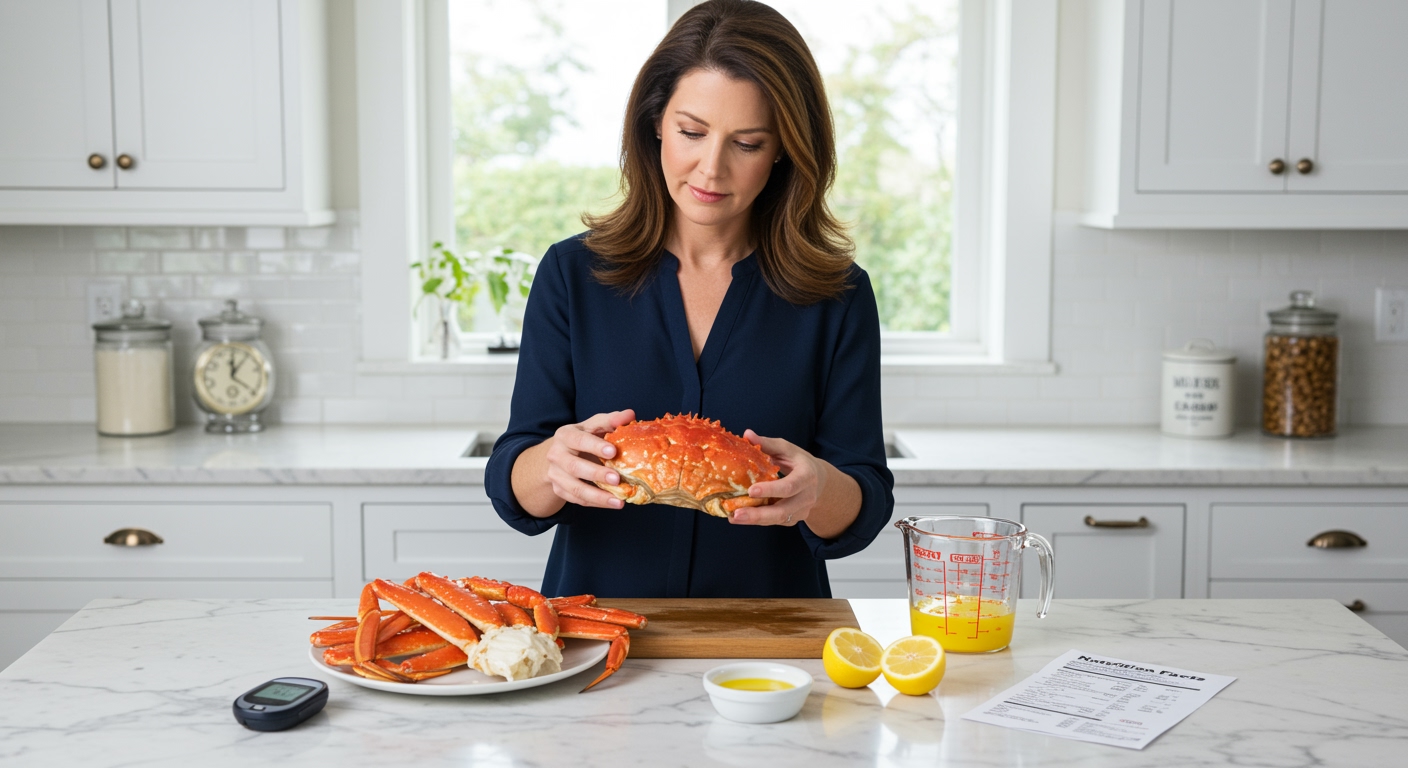✪ Key Takeaway: Crab is excellent for diabetes as it contains zero carbs, high protein, and beneficial omega-3 fatty acids that help control blood sugar.
Introduction
You walk past the seafood counter and see those beautiful crab legs on ice.
Your mouth waters but then doubt creeps in because you have diabetes and wonder if crab will mess with your blood sugar levels.
Hi, I am Abdur, your nutrition coach and today I am going to explain exactly why crab can be one of the best protein choices for managing your diabetes.
Does Crab Contain Carbohydrates That Affect Blood Sugar?
Crab meat contains zero carbohydrates in its natural form.
This means eating plain crab will not cause any direct spike in your blood glucose levels.
A 3-ounce serving of cooked crab provides about 16 grams of high-quality protein with absolutely no sugar or starch.
The protein in crab actually helps stabilize blood sugar by slowing down the absorption of any carbohydrates you eat with it.
However, you need to watch out for preparation methods and sauces that can add hidden carbs.
Breaded crab cakes, crab dips with crackers, or sweet and sour crab dishes will definitely impact your blood sugar because of added flour, breadcrumbs, and sugary sauces.
✪ Pro Tip: Always choose steamed, boiled, or grilled crab without breading or sugary sauces to keep carbs at zero.
What Nutrients In Crab Help With Diabetes Management?
Crab provides several nutrients that can actually improve diabetes control.
The high protein content helps maintain steady blood sugar levels throughout the day by preventing rapid glucose fluctuations.
Crab contains significant amounts of omega-3 fatty acids, particularly EPA and DHA, which reduce inflammation in your body.
Chronic inflammation makes insulin resistance worse, so getting these healthy fats can help your cells respond better to insulin.
The chromium content in crab is particularly interesting for diabetics because this mineral helps improve insulin sensitivity.
Crab also provides zinc, which plays a role in insulin production and storage in your pancreas.
The selenium in crab acts as an antioxidant that protects your cells from damage caused by high blood sugar levels over time.
✪ Fact: One serving of crab provides about 40% of your daily chromium needs, which helps your body use insulin more effectively.
How Does Crab Compare To Other Proteins For Diabetics?
When you compare crab to other protein sources, it stands out as exceptionally diabetes-friendly.
Unlike processed meats that often contain added sugars and preservatives, crab is a clean, natural protein source.
Red meats like beef and pork can increase inflammation and insulin resistance when eaten regularly, but seafood like crab has the opposite effect.
Chicken and turkey are good options, but they lack the omega-3 fatty acids that make crab special for diabetes management.
Fish like salmon and mackerel also provide omega-3s, but crab has the advantage of being lower in calories while still providing excellent nutrition.
Plant proteins like beans and lentils are healthy but contain carbohydrates that will raise blood sugar, unlike crab which contains none.
The complete amino acid profile in crab means your body can use all the protein efficiently for muscle maintenance and blood sugar control.
✪ Note: Crab provides more protein per calorie than most other animal proteins, making it ideal for weight management.
What Are The Best Ways To Prepare Crab For Diabetes?
The preparation method makes all the difference between a diabetes-friendly meal and a blood sugar disaster.
Steaming crab legs with herbs and spices gives you maximum flavor without adding any carbohydrates or unhealthy fats.
Boiling crab in seasoned water is another excellent option that keeps the preparation simple and carb-free.
Grilling crab with a light brush of olive oil and garlic creates delicious results while maintaining the diabetes benefits.
For dipping sauces, stick to melted butter with lemon juice, garlic aioli made with real mayonnaise, or cocktail sauce in very small amounts.
Avoid breaded crab cakes, crab rangoon, crab bisque with cream and flour, and any preparation that involves sweet sauces or batters.
When making crab salad, use mayonnaise or olive oil-based dressings instead of sweet dressings that contain added sugars.
✪ Pro Tip: Season crab with herbs like dill, parsley, and paprika instead of sugar-based seasonings to maximize flavor without carbs.
Are There Any Concerns About Eating Crab With Diabetes?
While crab is generally excellent for diabetes, there are a few considerations to keep in mind.
Crab is relatively high in sodium, which can be a concern if you also have high blood pressure alongside your diabetes.
A 3-ounce serving contains about 300-400 milligrams of sodium, so you should balance this with low-sodium foods throughout the day.
Some people with diabetes also have kidney problems, and excessive protein intake can strain the kidneys if the condition is advanced.
However, for most diabetics with normal kidney function, the protein in crab is beneficial rather than harmful.
Crab can be expensive, which might make it difficult to include regularly in your meal planning, but even occasional consumption provides benefits.
If you have shellfish allergies, obviously crab is not an option, but this is unrelated to diabetes and more about individual food sensitivities.
✪ Note: Always consult your healthcare provider about protein intake if you have both diabetes and kidney disease.
The Bottom Line
Crab is not just safe for diabetes – it is actually one of the best protein choices you can make for blood sugar control.
The best foods for diabetes are often the simplest ones that nature provides without human interference, and crab fits this perfectly when prepared properly.
I would love to hear about your experiences with including crab in your diabetes meal plan, or if you have any questions about preparing seafood in diabetes-friendly ways, please share them in the comments below.
References
At NutritionCrown, we use quality and credible sources to ensure our content is accurate and trustworthy. Below are the sources referenced in creating this article:





